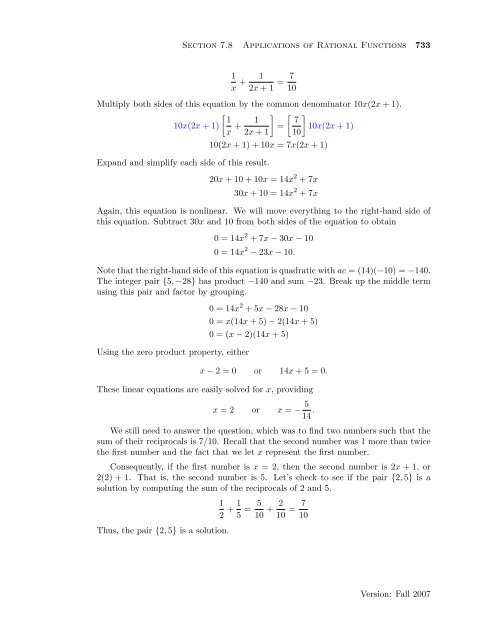Chapter 7 Rational Functions - College of the Redwoods
Chapter 7 Rational Functions - College of the Redwoods
Chapter 7 Rational Functions - College of the Redwoods
You also want an ePaper? Increase the reach of your titles
YUMPU automatically turns print PDFs into web optimized ePapers that Google loves.
Section 7.8 Applications <strong>of</strong> <strong>Rational</strong> <strong>Functions</strong> 733<br />
1<br />
x + 1<br />
2x + 1 = 7 10<br />
Multiply both sides <strong>of</strong> this equation by <strong>the</strong> common denominator 10x(2x + 1).<br />
[ 1<br />
10x(2x + 1)<br />
x + 1 ] [ 7<br />
= 10x(2x + 1)<br />
2x + 1 10]<br />
10(2x + 1) + 10x = 7x(2x + 1)<br />
Expand and simplify each side <strong>of</strong> this result.<br />
20x + 10 + 10x = 14x 2 + 7x<br />
30x + 10 = 14x 2 + 7x<br />
Again, this equation is nonlinear. We will move everything to <strong>the</strong> right-hand side <strong>of</strong><br />
this equation. Subtract 30x and 10 from both sides <strong>of</strong> <strong>the</strong> equation to obtain<br />
0 = 14x 2 + 7x − 30x − 10<br />
0 = 14x 2 − 23x − 10.<br />
Note that <strong>the</strong> right-hand side <strong>of</strong> this equation is quadratic with ac = (14)(−10) = −140.<br />
The integer pair {5, −28} has product −140 and sum −23. Break up <strong>the</strong> middle term<br />
using this pair and factor by grouping.<br />
0 = 14x 2 + 5x − 28x − 10<br />
0 = x(14x + 5) − 2(14x + 5)<br />
0 = (x − 2)(14x + 5)<br />
Using <strong>the</strong> zero product property, ei<strong>the</strong>r<br />
x − 2 = 0 or 14x + 5 = 0.<br />
These linear equations are easily solved for x, providing<br />
x = 2 or x = − 5<br />
14 .<br />
We still need to answer <strong>the</strong> question, which was to find two numbers such that <strong>the</strong><br />
sum <strong>of</strong> <strong>the</strong>ir reciprocals is 7/10. Recall that <strong>the</strong> second number was 1 more than twice<br />
<strong>the</strong> first number and <strong>the</strong> fact that we let x represent <strong>the</strong> first number.<br />
Consequently, if <strong>the</strong> first number is x = 2, <strong>the</strong>n <strong>the</strong> second number is 2x + 1, or<br />
2(2) + 1. That is, <strong>the</strong> second number is 5. Let’s check to see if <strong>the</strong> pair {2, 5} is a<br />
solution by computing <strong>the</strong> sum <strong>of</strong> <strong>the</strong> reciprocals <strong>of</strong> 2 and 5.<br />
Thus, <strong>the</strong> pair {2, 5} is a solution.<br />
1<br />
2 + 1 5 = 5 10 + 2 10 = 7 10<br />
Version: Fall 2007

















